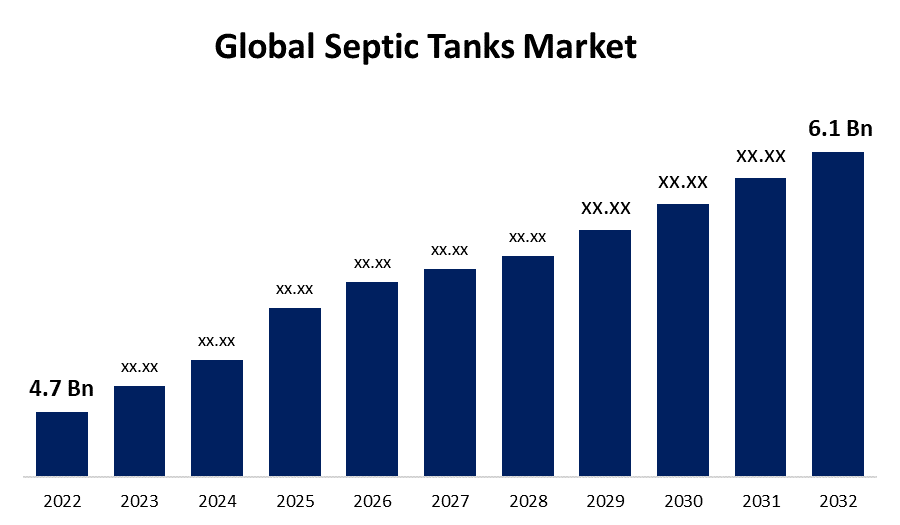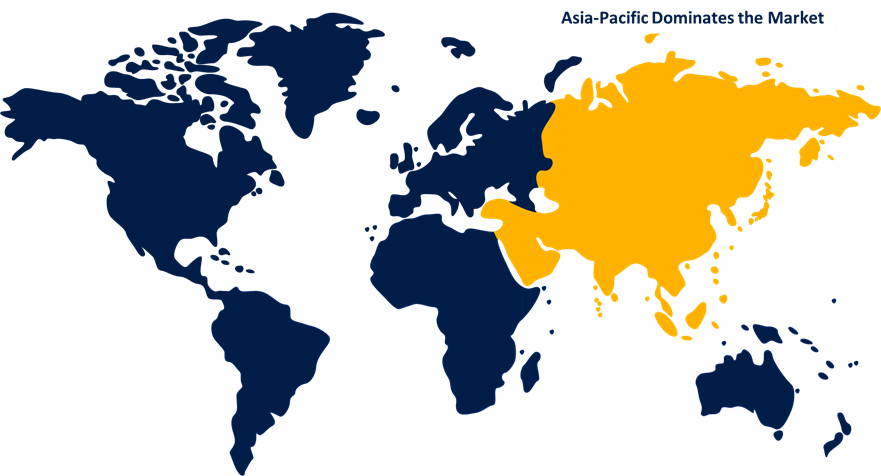Global Septic Tanks Market Size To Worth USD 6.1 Billion by 2032 | CAGR of 4.6%
Category: Chemicals & MaterialsGlobal Septic Tanks Market Size To Worth USD 6.1 Billion by 2032
According to a research report published by Spherical Insights & Consulting, the Global Septic Tanks Market Size To Grow from USD 4.7 Billion in 2022 to USD 6.1 Billion by 2032, at a Compound Annual Growth Rate (CAGR) of 4.6% during the forecast period.

Get more details on this report -
Browse key industry insights spread across 200 pages with 110 Market data tables and figures & charts from the report on the "Global Septic Tanks Market Size, Share, and COVID-19 Impact By Material (Plastic, Fiberglass And Concrete), By Application (Residential, Commercial, and Industrial), by Region (North America, Europe, Asia-Pacific, Latin America, Middle East, and Africa), Analysis and Forecast 2022 – 2032." Get Detailed Report Description Here: https://www.sphericalinsights.com/reports/septic-tanks-market
In suburban and rural areas without access to centralised sewage systems, septic tanks, a substantial underground wastewater treatment equipment, are widely used. Domestic wastewater from sinks, showers, toilets, and other plumbing fixtures is collected, stored, and treated by it. The core of the system is the septic tank, a watertight container often made of concrete, fibreglass, or plastic. It is buried beneath and receives all of the household wastewater. Septic tank systems require regular maintenance to function properly. Regular tank pumping is required to remove accumulated sediments and keep them from entering the drainfield, where they can lead to clogs and system failure.
COVID 19 Impact
Numerous construction projects were delayed or abandoned entirely as a result of safety concerns, mobility restrictions, and lockdowns during the early stages of the epidemic. It's possible that this led to a brief halt in construction or new septic tank installations. The real estate market was also impacted by decreased home sales and property transfers during periods of economic uncertainty. There may have been less need for new septic tank installations as a result. Many nations announced infrastructure improvements and stimulus initiatives to support their economies during the pandemic. Some of these initiatives may have supported wastewater management and sewage infrastructure, which may have benefited the septic tank industry. As a result of the epidemic, interest in suburban and rural living increased, and preferences for remote work and lifestyle changes were made. This development might have raised demand for septic tank installations in areas without centralised sewage services. Similar to many other industries, the septic tank industry may have struggled as a result of supply chain disruptions, a lack of materials, and rising prices.
The growing global population and the rapid urbanisation of developing countries were the main drivers of the need for housing and infrastructure, including sewage treatment systems like septic tanks. In many rural and semi-urban regions, centralised sewage systems were either not available or were not economically feasible. Septic tanks are frequently used to hold wastewater, but they can also be used for other purposes. The COVID-19 outbreak hastened the suburbanization and ruralization of society, which has increased demand in areas without centralised sewage infrastructure. The installation of septic tanks in some regions became more popular as a result. Septic systems have become more efficient and environmentally benign as a result of technological advancements in the septic tank industry.
In places with poor infrastructure or challenging access, transporting and constructing septic tanks can be challenging and expensive, which may limit their widespread use. In order to eliminate accumulated sediments, septic tanks require regular maintenance and frequent pumping. Some users might neglect maintenance, which would lead to system failures, environmental damage, and costly repairs. Septic tank installation requires upfront payment for all personnel, material, and excavation charges. This initial expense may be too expensive for some households or businesses.
Establishing a septic tank system requires upfront payment for work, supplies, and excavation charges. This up-front cost could be exorbitant for certain business or house owners.
Material Insights
Concrete segment is dominating the market over the forecast period
On the basis of material, the global septic tanks market is segmented into Plastic, Fiberglass, Concrete, and Others. Among these, the concrete segment is dominating the market with the largest market share over the forecast period. The strength and durability of the septic system are well-known. Because of their ability to withstand external stresses, they are less likely to be damaged than other materials. Concrete is a commonly available material, and numerous companies from various areas create septic tanks made of concrete, assisting in the expansion of the market for these goods. In suburban and rural areas without access to centralised sewage networks, concrete septic tanks have long been a popular choice for on-site wastewater treatment.
Application Insights
Residential segment accounted the largest market share over the forecast period
Based on the application, the global septic tanks market is segmented into Residential, Commercial, and Industrial. Among these, the residential segment accounted the largest market share over the forecast period. As people grow more conscious of their environmental impact, some residences may choose to use septic tank systems, which offer a more decentralised and environmentally beneficial approach of wastewater treatment. Some private residents prefer individual on-site wastewater treatment systems, such as septic tanks, since they provide them greater control over their wastewater disposal than centralised sewer systems do. New neighbourhoods are being developed and those that already exist are being enlarged as the population of the world rises. In order to manage household wastewater, additional septic tank systems are necessary.
Regional Insights
Asia Pacific region accounts the largest market share over the forecast period

Get more details on this report -
Among all other regions, the Asia Pacific region accounts the largest market share over the forecast period. The Asia-Pacific region has seen a noticeable increase in population, particularly in countries like India, China, and Indonesia. This demographic growth has increased the demand for homes and infrastructure, including septic tank systems. Despite the region's increasing urbanisation, centralised sewage systems are still only occasionally accessible in many rural areas. In the United States, using a septic tank is a standard practise. As economies age and lifestyles change, interest in suburban and rural living has increased. Due to the increasing number of individuals who rely on them as a source of income and the availability of a wide range of services, there is an increasing need for septic tanks.
North America is witnessing the fastest market share over the forecast period. In North America, there are a lot of suburban and rural areas without centralised sewage systems. Because of this, septic tanks are now used more frequently as a supply of water for residential homes. The growth of the housing and real estate industries in North America, particularly in new residential buildings where centralised sewer connections would not be practicable, has fueled the need for septic tanks.
Market Segment
This study forecasts revenue at global, regional, and country levels from 2019 to 2032. Spherical Insights has segmented the global Septic Tanks Market based on the below-mentioned segments:
Septic Tanks Market, Material Analysis
- Plastic
- Fiberglass
- Concrete
- Others
Septic Tanks Market, Application Analysis
- Residential
- Commercial
- Industrial
Septic Tanks Market, Regional Analysis
- North America
- US
- Canada
- Mexico
- Europe
- Germany
- Uk
- France
- Italy
- Spain
- Russia
- Rest of Europe
- Asia Pacific
- China
- Japan
- India
- South Korea
- Australia
- Rest of Asia Pacific
- South America
- Brazil
- Argentina
- Rest of South America
- Middle East & Africa
- UAE
- Saudi Arabia
- Qatar
- South Africa
- Rest of Middle East & Africa
About the Spherical Insights & Consulting
Spherical Insights & Consulting is a market research and consulting firm which provides actionable market research study, quantitative forecasting and trends analysis provides forward-looking insight especially designed for decision makers and aids ROI.
Which is catering to different industry such as financial sectors, industrial sectors, government organizations, universities, non-profits and corporations. The company's mission is to work with businesses to achieve business objectives and maintain strategic improvements.
CONTACT US:
For More Information on Your Target Market, Please Contact Us Below:
Phone: +1 303 800 4326 (the U.S.)
Phone: +91 90289 24100 (APAC)
Email: inquiry@sphericalinsights.com, sales@sphericalinsights.com
Contact Us: https://www.sphericalinsights.com/contact-us
Need help to buy this report?